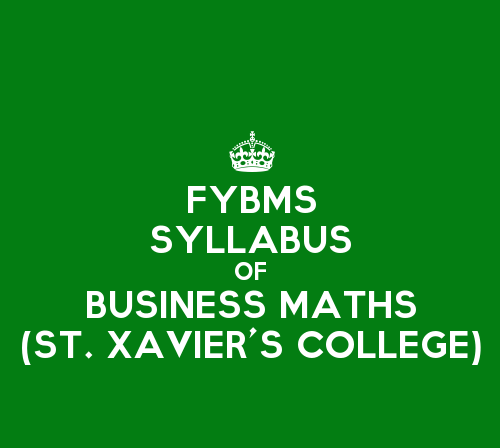Business Mathematics is a subject of Semester 1 in FYBMS at St. Xavier’s College. Business Mathematics subject aims to equip the BMS students with a broad based knowledge of mathematics with emphasis on business applications.
There are 4 main units in the subject of Business Mathematics:
Unit 1 – Elementary Financial Mathematics – 15 lectures
Unit 2 – Matrices and Determinants – 15 lectures
Unit 3 – Derivatives and their Applications – 15 lectures
Unit 4 – Functions of two variables and Integration – 15 lectures
The topics covered in Unit 1 – Elementary Financial Mathematics are as follows:
- A.P., G.P., and sums of their first n terms.
- Problems with business applications.
- Simple interest, compound interest, interest compounded more than once a year nominal,
- Effective and continuous rates of interest.
- Immediate (ordinary) annuity, its present value and future value.
- Equated Monthly installments (EMI) using reducing interest system,
- Amortization of loans.
- Sinking fund.
- Depreciation of assets.
- Functions: constant function, linear function, step function, xn, exponential and logarithmic functions.
- Business and Economics functions such as demand supply, total revenue, average revenue, total cost, average cost and profit function.
- Equilibrium point.
- Break even analysis.
- Notion of permutations and combinations.
- (Problems to be solved with calculator. Use of logarithm tables to be avoided)
The topics covered in Unit 2 – Matrices and Determinants are as follows:
- Matrices,
- Matrix Operations (Addition of 2 matrices, scalar multiple of a matrix, matrix multiplication, transpose of a matrix).
- Determinant of a matrix of order 2 and 3,
- Elementary properties of determinant,
- Solving a system of linear equations (upto 3 variable) using Cramer’s rule and application to business problems.
- Elementary row and column operations on matrices,
- Inverse of a matrix (up to order 3),
- Application of matrices to Leontief’s open input-output model,
- Linear inequality (upto 2 variables) and their graphs.
The topics covered in Unit 3 – Derivatives and their Applications are as follows:
- Derivatives as a measure of rate.
- Derivatives of functions – constant function,
- X”, ex, ax, log x.
- Rules of derivatives – Scalar multiplication, sum, difference, product and quotient.
- Second order derivatives.
- Application of derivatives – marginal cost, marginal revenue, elasticity of demand, maxima and minima for functions in Economics and Business.
The topics covered in Unit 4 – Functions of two variables and Integration are as follows:
- Functions of two variables with examples from Economics and Commerce such as Cobb-Douglas and other production functions,
- Demand functions involving 2 commodities.
- First and second order partial derivatives,
- Marginal functions and their simple applications in Economics.
- Maxima and Minima of functions of two variable using second order partial derivative criterion.
- Constrained maxima and minima (one constraint only) using Lagrange’s multiplier.
- Simple applications in Economic and Commerce:
- Marginal physical productivity of labour and capital,
- Demand analysis of complementary and competitive commodities,
- Partial elasticity,
- Optimization of functions of two variables in economics and business.
- Integration as the reverse process of derivatives,
- Standard formulae – integration of constant function, xn, ex, ax, log x.
- Rules for integrals – sum, difference and scalar multiplications.
- Simple problems (Integration techniques such as finding total cost from marginal cost, total revenue from marginal revenue)
- Definite integrations, simple problems (no properties),
- Applications such producer’s surplus,
- Consumer’s surplus,
- Present value and future value of a continuously compounded annuity.
Continuous Internal Assessment:
- Mid Semester Test
- Assignment
The list of Reference Books for Business Mathematics are:
- Mathematics for Economics and Finance, Martin Anthony, Norman Biggs Cambridge low-price editions, 2000.
- Business Mathematics, D.C. Sancheti, V.K. Kapoor, Sultan Chand & Sons Publications, 2006.
- Mathematics for Business and Economics, J.D. Gupta, P.K. Gupta, Man Mohan Tata McGraw-Hill Publishing company Ltd.
- Mathematical Basis of Life Assurance IC – 81: Insurance Institute of India, 2006.
- Mathematics of Finance 2nd Edition Schaum’s Outline Series, Peter Zima, Robert Brows Tata McGraw – Hill Publishing Co. Ltd.




52 Comments